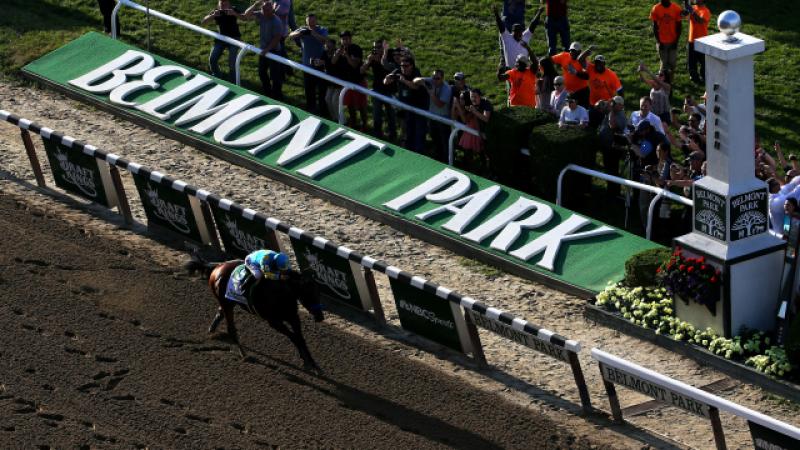What Happened When A Novice Tried Out The Belmont Stakes Horse Race



I’d never been to the races, so when an invitation came along to join a group of friends and witness the third leg of the Triple Crown—the Belmont Stakes—I had to do it. On a glorious Saturday spring morning, I boarded the Long Island Rail Road and headed out to the track.
By the time I was embedded in a sea of pastel, preppy twenty-somethings on the train I figured I should get some understanding of horse racing, and the horses we’d be seeing compete. Turns out there would be 13 races, different horses in each one, with the 11th race being the official Belmont Stakes.
More exciting than picking a horse was picking my hat. I took selfies in my best four hats (I only have four hats) and sent them to friends to help me pick. We settled on a simple summer hat, with a vibrant Pucci scarf and a prim, navy blue dress. I don’t have lots of chances to get dressed up, so I embraced it, in my prim, navy blue way. I donned my hat as I stepped off the train at Belmont Park. I still didn’t know anything about the horses.
Gambling is one of the only vices I’ve had no trouble rejecting, for the simple reason that I find no joy in being tense about money. But I am all about embracing an experience, fully embarking upon everything it has to over, and as such, I figured it wouldn’t be an authentic day at the races if I didn’t put down some cash. I dedicated $20 to the enterprise, more interested in snacks and rosé on this lovely, sunny day.
I purchased an overpriced but right on time sparking rosé and proceeded to the window to place my bet. I was intercepted by a rep from New York Racing Association (NYRA), who told me there was an app for that. I downloaded it and got my first look at the horses in all the races. A quick glance at the horses’ names gave me inspiration. Intrepid Heart was a 10-1 shot in the 11th, and based on the glory of name alone, I knew that was my horse. I have an intrepid heart, so I figured we were simpatico.
I uploaded $20 to my betting account and doled out small sums across the first 11 races. Still, it had the feeling of an anti-climax. Most of the betting windows had touch screens, which also had an inauthentic feel. I wanted to be part of this place, and to be part of a place means to communicate with the people of that place. I made my way to a betting window with an actual person behind the glass.
The woman behind the window accepted my $15 and gave me two slips, which I carefully tucked into my wallet. My betting was now up to $35. For all the high spenders out there, I’m sure this is chump change, but for my freelancing self, this was big spending. I started to get a sense of how betting on the horses can become something of an obsession. It made the races more exciting to have money on the line, but more than that, the outlay of a bet brings with it a feeling of hope and anticipation.
So long as the race isn’t yet run, and my horse hadn’t yet lost (spoiler alert: my horse lost), I had the fantasy of a big payout, and all the things I could do with that money. Waiting to see if you’re a winner opens a door in your imagination. It was a joy to live in hope.
Horse racing has come under scrutiny with a spate of recent horse deaths. Since late December, 27 horses have died at Santa Anita, California, and NPR recently reported that Kentucky underreports horse fatalities. Activist organizations want to put a stop to racing, saying that the conditions are inhumane and that there’s no other sport where the athletes are treated as chattel, drugged, doped, and whipped without their consent.
In watching the horses hurl themselves around the track, they for sure look fragile. Their spindly legs hold up these giant bodies, with jockey near hovering atop, riding stirrups more than the saddle. They run in a clump, a tangle, each horse and rider vying for position. An ambulance follows the pack at a short distance. The danger of the enterprise is front and center.
The trumpets announced each race, just like in a Bugs Bunny cartoon. With every race, the drunkenness of the crowd increased. In the 8th, I had money on Hog Creek Hustle to place, and he won, but there was an inquiry about interference with horse number nine. He was exonerated, and we all cheered for him, and for ourselves. I’d tell you what his odds were, but I don’t really know. I won $7.60 on my $1 bet.
We snuck up to the clubhouse level earlier in the day and it really would have been worth the price of admission. The general admission level began to take its toll on the young crowd, where the event was as much an opportunity to try on their most obnoxious drunken personalities and awkwardly grope each other as it was to place a wager. The scene devolved into a drunken mess before the 10th. The heels start breaking apart. The girls cry into their cell phones on benches, the bros looking even more desperate in their beer-dampened petal pink button-downs and deck shoes.
All the races seem to have names, but the only ones I caught were the Manhattan, which was the 10th, and of course the 11th. Between the 10th and the 11th, the final leg of the Triple Crown—the Belmont Stakes—for which the day is named, is an hour interlude. It’s a long hour. Standing in the sun with a bunch of inebriated finance bros drunk on Belmont Juleps and ego is headache-inducing.
If you’re gonna go, here are some tips: You need only cash, and a credit card for when you run out of that; you need sunscreen if you burn. You need a sense of humor, sunglasses, and if you don’t normally wear heels or just aren’t that into bondage, wear flats. You need a cute dress, but make sure it’s comfortable, and effectively covers your rear so that when you’re too drunk to remember to cover your rear, your cute dress picks up the slack.
Do not forget your hat. It does not matter if you’re not a hat person, just go with a fascinator like a British royal wedding, and keep it on. It doesn’t matter if you feel silly; that’s at least half the point. Make sure to have a good breakfast. You’re gonna be drinking in the sun all day, and you don’t want to end up a complete disaster by the end.
The buildup to the Belmont Stakes was really exciting. By that time, I’d thoroughly embraced the experience. Intrepid Heart was number eight, and I kept my eye on the board. I strained to hear the commentary over the loudspeaker but could hear nothing intelligible over the roar of the crowd.
By the time the horses left the gate, I had all my hopes and dreams for my future pinned on at least a showing for Intrepid Heart. My imagination was captured by the name. Even so, the loss wasn’t particularly devastating, given I got to experience some of the best.

By Libby Emmons
JUNE 10, 2019
 Article is LOCKED by author/seeder
Article is LOCKED by author/seeder







You no longer have to be there to bet the races, but there is nothing quite like the experience of actually being there. As far as Ms Emmons goes, I can only add that the experience is most enhanced by the young & innocent.
There was a time , mostly pre world war two, when horse racing was a more popular spectator sport than basketball, football, or hockey, of our major sports today, only baseball was as popular as horse racing. If you consider that the cost of an NFL or NBA or MLB ticket can run into three figures , the small entrance fee into a racetrack can seem like a bargain today and you might still have a few dollars for a couple wagers.
The drawback became that the modern day sports fan doesnt like to watch horses race unless they have money on it, and that can quickly become very expensive.
You are absolutely correct. If you go back to the 19th century both Baseball & Horse Racing were extremely popular. Some feel that both rightly belong to that era. I should note the demise of the sport of Boxing.
The drawback became that the modern day sports fan doesnt like to watch horses race unless they have money on it
That's always been true. The drawback was when states legalized other forms of gambling like the lottery and Casino's, which at one time only existed in Las Vegas. There is only so much gambling money to be wagered and Horse Racing has faced enormous competition for the bettors dollar. They were once the only legal game in town. Now most of the smaller race tracks are gone. The big circuits in NY, CA and Florida get most of the spotlight. I would hate to see the grand game die. Around here my friends call me "teach", I show them how it's done.
Well, horse racing can be incredibly cruel to the horses. Think of the Lippizaners (sp?) - they don't even get a person on their back until they're something like 3 years old and their muscles are developed, plus they don't have as fragile legs as thoroughbreds. A thoroughbred starts racing at age 1 (and their birthdays are all considered January 1, which causes additional issues with them not being developed enough) and is retired at 3. That might help account for all the injuries and deaths of race horses.
There are still a lot of racetracks but they race less days a week now. Tracks used to race five and even six days a week and now it is usually four.
Many of the tracks have casinos on site, which has helped purses. Illinois just legalized casinos at the tracks and it will likely put Arlington back into the big leagues in a year or two.
I once knew a harness horse trainer when I was very young. He told me that the day they (race horses) can't pay for themselves, they get sold to the killers (slaughter house). Of course it's different for the horses who earned the right to be bred. For them it's a life of sex and prancing in the grass.
A thoroughbred starts racing at age 1
Nope, they don't start racing until age 2
and is retired at 3
Nope, they can race until their 12 -14, if they survive, not sure of the cut off point.
That might help account for all the injuries and deaths of race horses.
A horse is a 4 beat animal with one leg coming down one at a time. He carries his own weight plus the jockey at top speed. It is the racing stress that causes the breakdowns. I suppose, as with domestic farm animals, we wear them out.
It is a dangerous game for all concerned
The only horses that retire at the age of 3 are the ones who win extreme amounts of money early and have a stud value to high to risk, and those who are injured or never develop. The great majority of horses who actually have raced run past their three year old year. If they stay healthy it is not at all uncommon to see horses racing at 6 years old and at the smaller tracks you will see them racing at 7 or 8 years old and occasionally even older than that.
Yes John, that is what helped save the game.